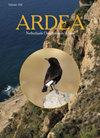Effects of Roach Rutilus rutilus Collapse on Abundance, Distribution and Diet of Great Cormorants Phalacrocorax carbo in a Large River in North-West Europe
IF 1.3
4区 生物学
Q3 ORNITHOLOGY
引用次数: 1
Abstract
Aquatic habitats are subject to multifactorial changes including global warming, invasive species colonisation, modification of organic and micro-pollutant discharge and, for large rivers in Europe, drastic physical modification (e.g. channelisation, impoundments). The Meuse River in Belgium is one of these multi-stressed environments, in which recent decreases of fish populations were observed, with the loss of 90% of Roach Rutilus rutilus biomass in only a few years. In the light of this fish stock collapse, diet modification and local population evolution of a key avian predator, the Great Cormorant Phalacrocorax carbo, were examined. The diet composition and daily consumption rates of the Great Cormorants feeding in the river were largely similar to that seen before the fish population collapsed. Numbers of wintering Great Cormorants decreased by 90%, as did Roach numbers, and thus the predation pressure was adjusted to the decreased fish availability. The number of night-roosts and locations remained unchanged and no redistribution to adjacent habitats was observed at the regional scale. We suggest a bottom-up chain of responses where a fish collapse forced a reduction in Cormorant numbers, being the main piscivorous avian predator, rather than a modification of Cormorant prey composition and/or a local redistribution to adjacent wetlands (top-down). The factors that govern the establishment of a small and productive breeding population remain to be explained, but we hypothesise that the start of breeding could well have been alleviated by the large decrease in number of wintering birds.欧洲西北部一条大河中蟑螂(Rutilus)崩溃对大鸬鹚(Phalacrocorax carbo)丰度、分布和饮食的影响
水生栖息地受到多因素变化的影响,包括全球变暖、入侵物种定殖、有机污染物和微污染物排放的改变,以及欧洲大河的剧烈物理改变(如渠化、蓄水)。比利时的默兹河(Meuse River)就是这种多重压力环境之一,近年来观察到鱼类种群数量减少,在短短几年内损失了90%的蟑螂(Roach Rutilus Rutilus)生物量。鉴于这种鱼类资源的崩溃,研究了主要鸟类捕食者大鸬鹚(Great Cormorant Phalacrocorax carbo)的饮食改变和当地种群进化。在河中觅食的大鸬鹚的饮食组成和每日消费率与鱼类数量锐减之前的情况基本相似。越冬大鸬鹚的数量减少了90%,蟑螂的数量也减少了90%,因此,捕食压力被调整为鱼类可用性的减少。在区域尺度上,夜栖的数量和位置保持不变,没有再分布到邻近生境。我们提出了一个自下而上的响应链,其中鱼类崩溃迫使鸬鹚数量减少,而不是改变鸬鹚的猎物组成和/或局部重新分配到邻近的湿地(自上而下)。控制小而多产的繁殖种群建立的因素仍有待解释,但我们假设,繁殖的开始很可能由于越冬鸟类数量的大量减少而得到缓解。
本文章由计算机程序翻译,如有差异,请以英文原文为准。
求助全文
约1分钟内获得全文
求助全文
来源期刊

Ardea
生物-鸟类学
CiteScore
2.10
自引率
0.00%
发文量
49
审稿时长
>12 weeks
期刊介绍:
Ardea is the scientific journal of the Netherlands Ornithologists'' Union, and is published since 1912. The journal welcomes manuscripts reporting significant new findings in ornithology, in particular those covering the ecology, life history, and evolution of birds, and including sound descriptive work. Ardea publishes Original research papers, Short notes and Book reviews. In addition to the regular three issues per year, Ardea publishes specials that contain conference or workshop proceedings (produced on request).
 求助内容:
求助内容: 应助结果提醒方式:
应助结果提醒方式:


